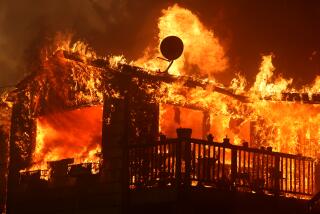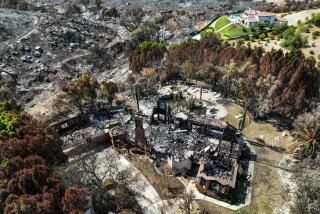Spending to fight California wildfires surpasses $1 billion
Wildfire spending in California continued its upward climb this year, driven by one of the worst fire seasons in the state’s history.
Almost a quarter of all the wild land that burned across the country in 2008 was in California -- roughly 1.4 million acres.
The fires, fought at a huge cost to taxpayers, failed to translate into any meaningful reforms at the state or federal level despite efforts in Sacramento and Washington.
Lawmakers introduced a number of measures dealing with land use, fire prevention and protection. But the proposals stalled, or in the case of one major state bill, were vetoed.
In fiscal 2008, half of the $1.4 billion that the U.S. Forest Service spent nationally on wildfire suppression was spent in California alone. State fire expenditures topped $1 billion.
“I think we’ve seen unprecedented fires,” said Ruben Grijalva, director of the California Department of Forestry and Fire Protection.
Much of the California acreage burned in early summer, when an unusually fierce dry-lightning storm sparked more than 2,000 wildfires from Monterey County to the Oregon border. The biggest blaze scorched the mountainous Big Sur coast, forcing evacuations and closing California 1.
In the fall, the action shifted to Southern California, where the Marek, Sesnon and Sayre fires blew across the brushy hills of Los Angeles County, reducing hundreds of mobile homes to smoldering heaps. In Orange and Riverside counties, the 30,000-acre Freeway Complex blaze destroyed nearly 200 residences. And the Tea fire chewed its way through Montecito neighborhoods.
All told, an area nearly three times the size of Orange County burned throughout the state. More than 2,300 structures were destroyed.
Statistics like that are driving efforts to adopt preventive measures.
“The solution is not just more engines, more airplanes,” said Grijalva, who previously served as state fire marshal and Palo Alto’s fire chief.
But the past year underscores how much easier it is to open the funding spigot than to pursue more fundamental reforms to rein in firefighting costs or shift more of the financial burden to those who live in high fire-hazard zones.
State Sen. Christine Kehoe (D-San Diego) sponsored several measures that went nowhere. One would have raised an estimated $43 million a year for fuel-reduction projects and state inspections by imposing a $50 fee on residences in areas protected by the state Department of Forestry and Fire Protection.
A bill written by Assemblyman Dave Jones (D-Sacramento) would have required that new subdivisions in high fire-risk areas have two access roads to ensure that residents could get out and fire engines could get in during an emergency. Developers also would have had to show that they had adequate water pressure and fire protection.
The proposal, supported by firefighter associations, was listed as a “job killer” by the state Chamber of Commerce, which argued that it could virtually shut down suburban development in certain parts of the state. The bill was passed by the Legislature but vetoed by Gov. Arnold Schwarzenegger.
“There is an absolute disconnect between requiring state taxpayers to take on the ever increasing burden of fighting fires when it’s the decisions at local levels to put more homes and people in harm’s way,” Jones said, disputing that the measure amounted to a building moratorium. He said he plans to work with Kehoe to reintroduce similar legislation in the coming year.
U.S. Sen. Dianne Feinstein (D-Calif.) helped push through an appropriations bill that provided $910 million in emergency funds for federal firefighting and fuel-reduction efforts. But her proposal to give incentives to communities around the country to adopt a model fire-safe ordinance dealing with building codes and defensible space fizzled.
Another bill, sponsored by Rep. Nick Rahall (D-W.Va.) -- chairman of the House Natural Resources Committee -- would have created a new federal account to pay for major wildfires, shifting the cost from the U.S. Forest Service budget. It too failed.
Local resistance to state fees and mandates played a major role in blocking the Kehoe and Jones bills. But reform proponents are not giving up.
“I’m not pushing for a state mandate,” Grijalva said. “But I’m pushing for a process that would allow a very public review of those decisions being made that also take into consideration what the local [firefighting] response capability is, what the local prevention and enforcement capabilities are, what the local building standards are.”
Grijalva said fire officials also are considering experimenting with a version of Australia’s stay-and-defend program: Rather than evacuating, homeowners are trained to protect their residences from the shower of embers that are typically more of a threat during a wildfire than encroaching flames.
“You’ll start seeing pilot programs of what they do in Australia, with some modifications in California -- huge education programs,” Grijalva said.
The Department of Forestry and Fire Protection is training insurance industry inspectors on state requirements to clear house perimeters of flammable material. And fire officials are mulling whether some aspects of the state’s recently enacted building standards for high fire-hazard zones should come into play when homeowners remodel. For example, if someone replaces a deck, they might have to use fire-resistant building materials.
Although significantly fewer acres burned across the U.S. this year than last year, the Forest Service spent slightly more nationally on fire suppression in 2008 than the previous year.
“Not all acres are equal,” said Agriculture Undersecretary Mark Rey, who oversees the Forest Service.
He pointed out that it is costlier to fight fires in California than in many other states. And the federal fiscal year begins in October, so it included the fall 2007 firestorm in Southern California as well as last summer’s lightning blitz.
Rey said he believed the agency had succeeded in slowing the rise in firefighting costs, which have ballooned with a jump in burn acreage over the last decade.
Still, he cautioned, “that rate is going to continue to increase as a consequence of fire and fuels conditions and drought,” and the spread of development on the wild land fringe.
The Forest Service is starting to embrace a strategy that it hopes will help contain costs. Rather than aggressively attacking every front of a fire, it allows managers to pull back in remote areas while focusing on more critical points. But that approach is unlikely to see much use in the developed areas of California.
Although federal spending on forest fuel reduction has increased significantly in recent years, it continues to lag far behind firefighting costs, both in California and nationally.
“I don’t think you can take money from suppression to do fuels treatment,” Rey said. “Suppression money is what saves lives and homes, so that’s not going to be a very popular posture.”
--
More to Read
Sign up for Essential California
The most important California stories and recommendations in your inbox every morning.
You may occasionally receive promotional content from the Los Angeles Times.











